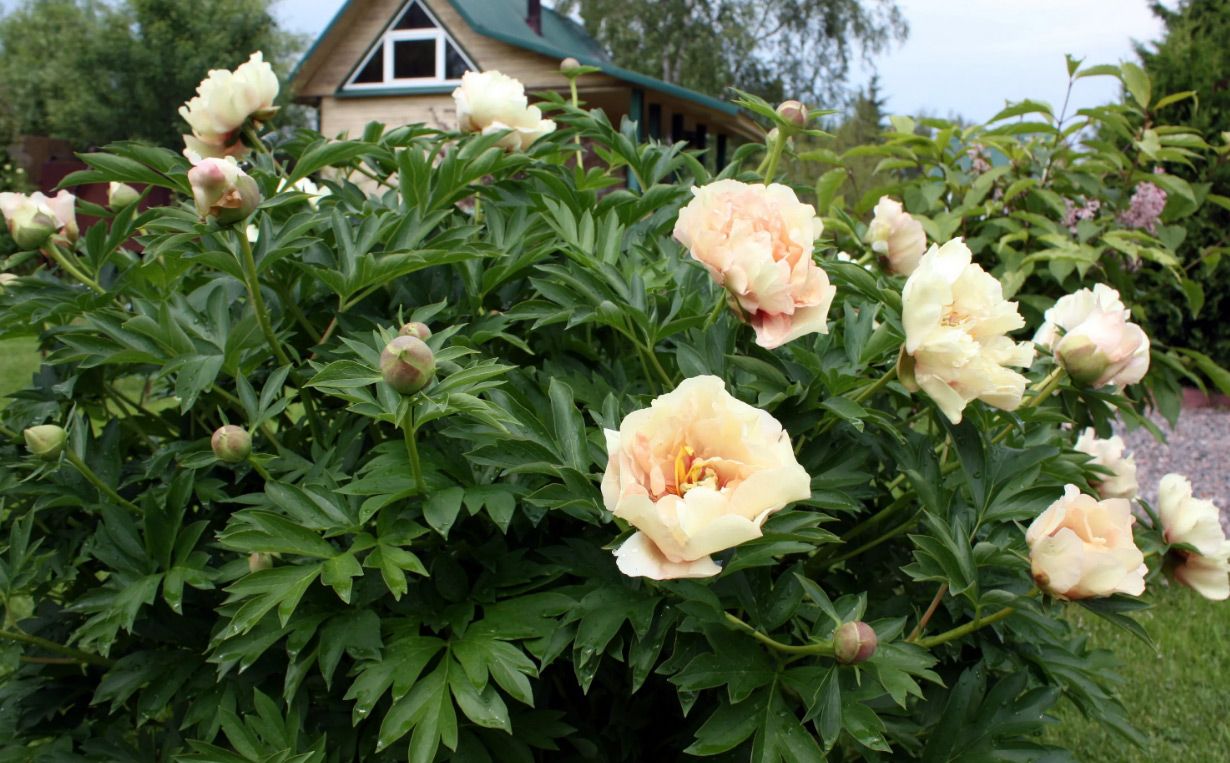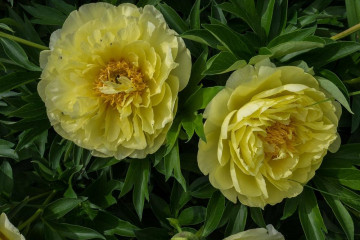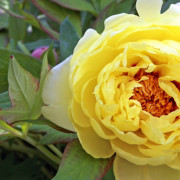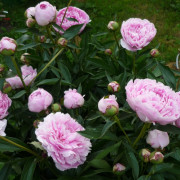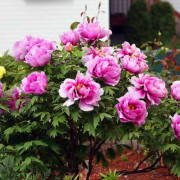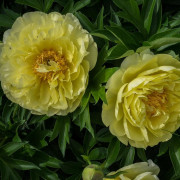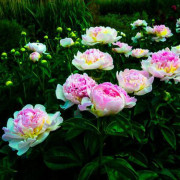Peony Canary Brilliants (Paeonia Canary Brilliants)
Content:
Peony Canary Brilliant (hybrid) can be safely called one of the brightest representatives of Ito hybrids. Summer residents and landscape designers highly appreciate this variety for its undemanding care and large double buds.
Peony Ito Canary Brilliant (Paeonia Itoh Canary Brilliants) - what is this variety, history of creation
The Canary Brilliants flower is an Ito hybrid that comes in a semi-double or double form. This variety was bred by breeders thanks to the crossing of two types of peonies: herbaceous and tree-like.
Brief description, characteristic
The Canari peony is presented in the form of a bush of the Ito group, which consists of several strong stems and most often reaches a height of 90-100 cm.In the absence of thinning, the bush can branch strongly and reach a diameter of 80-90 cm.
The leaves of the peony are relatively large and leathery, painted in a rich dark green hue. Particular attention should be paid to the flowers of the plant. These are double or semi-double buds.
Advantages and disadvantages of the variety
Peony Itoh Canary Brilliants has a number of main advantages that cannot be ignored:
- Frost resistance. Mature plants with additional cover can withstand up to -25 ℃.
- Unusual coloration. In the spring, at the beginning of flowering, the buds have delicate soft shades, and by the end of summer they become more intense and dark.
- Most hybrid peony varieties are characterized by large buds and a large number of flowers on the bushes.
- Well taken after breeding.
Of the shortcomings, only 2 factors can be named:
- They react poorly to heat. If summer in the region is accompanied by high temperatures (more than + 25 ℃), then the bushes should be planted in semi-shaded places.
- Watering sensitivity. Waterlogging of the soil should not be allowed.
Use in landscape design
Peony Keneri Brilliant can successfully fit into any landscape design. You can use such a plant for several purposes:
- Solo. On a green manicured lawn, peonies (one or more bushes) will look most impressive. In this case, nothing will distract attention from large double flowers.
- In mixborders. Roses, clematis, phlox are suitable for peonies as neighbors. They are also planted next to conifers: small pines or junipers.
Growing a flower, how to plant it in open ground
The health of the plant, its growth and flowering largely depends on the correct preparation and planting. For this reason, attention should be paid to the preparation of the soil and planting material.
Planting by root cuttings
The easiest way to plant these flowers is by dividing the bush.In order for the plant to grow quickly, you need to choose the right mother bush. In this case, it is important to comply with a number of conditions:
- The donor plant should not be too young. The best age for breeding is 3-4 years. At this time, a large number of buds already appear on the bushes.
- The rhizome of the flower must be well developed.
What time is the boarding
The division of the mother bush and the planting of the delenka are best done in the fall. August and the first half of September are well suited. Overwintered peonies will actively grow in early spring.
Location selection
Peony Canary Brilliants takes root well in loamy soil, the acidity of which is close to neutral. The flowering activity directly depends on the degree of illumination, therefore it is better to choose an area in the sun or in a light partial shade.
How to prepare the soil and flower for planting
Part of the separated rhizome with buds should be properly prepared for planting in open ground. To do this, immediately after separation from the mother bush, they are treated in a solution of potassium permanganate. The soil is prepared 7-8 days before planting.
First of all, a pit with dimensions of 70 × 70 × 70 cm is organized.The distance between the bushes of peonies should be at least 0.7-1 m.At the bottom of the pit, several layers are laid:
- drainage, because excess moisture has a bad effect on the growth and appearance of flowers, therefore it is important to provide a drainage layer of 15 cm;
- compost and fertilizers, which are used as mineral compositions.
Planting procedure step by step
When planting, the following types of work are performed:
- A rhizome with buds is placed in a pre-prepared hole.
- Carefully cover the hole with earth. In this case, you need to ensure that the kidneys are not deeper than 5 cm from the surface of the earth.
- The earth is tamped down and left to winter.
Seed planting
Summer residents and flower growers practically do not use this method of planting. Dividing the rhizome allows you to solve the problem of reproduction as efficiently as possible with minimal effort.
Plant care
In order for an ornamental plant to please with its bright greenery and abundant flowering, no special care is required. It is enough to maintain soil moisture, periodically fertilize the bushes and, if necessary, treat against pests.
Watering and feeding
Watering the bushes begins in early spring. Each bush requires 2-3 buckets of water, which is introduced into the root zone. The frequency of watering can be different and depends on the climatic characteristics of the region.
It is recommended to fertilize Ito Canari Diamonds peony 3 times per season:
- After the snow melts, nitrogen and potassium (10 g each) are scattered near each bush. After that, the root zone is watered.
- During bud formation. To the already named components add 15 g of phosphorus.
- After the end of the flowering period (after 12-14 days), each bush is fed with potassium (12 g) and phosphorus (20 g).
Mulching and loosening
To prevent the topsoil from drying out, the ground around the flowers is mulched. This term is understood as sprinkling the soil with this or that material. This is done in order to reduce moisture loss and prevent cracking of the soil. For peonies, the easiest way is to sprinkle the ground with straw or peat.
Frequent loosening of the top layer can replace mulching. It should be carried out some time after the next watering.
Preventive treatment
In order to prevent infection of the bushes with fungal diseases, experienced flower growers recommend treating with Fitosporin biofungicide or soapy water. It is better to carry out such procedures before the first signs of infection appear.
Peony Blossom Canary Diamond
The flowering period of the plant is relatively long, while many large velvet buds appear on the bushes. To maintain the beauty of peonies, they need additional care during this time.
Flowering and resting period
Young peony Brilliant usually does not give flowers in the first 1-2 years. If flowers appear, they are often irregular in shape. Cutting the buds helps to fix this. Starting from 3-4 years, the plant is considered an adult and blooms actively from the end of April or the beginning of May. The end of the flowering period is at the end of July.
Care during and after flowering
Peonies bloom actively for a long time. The plant takes a lot of energy to do this. To constantly keep the flowers in good condition, you should be careful about regular watering and feeding.
What to do if the flower does not bloom, possible reasons
If the plant does not give flowers at 2–3 years of age, there may be several reasons:
- Lack of sunlight.
- Acidified soil. Lack of fertilizer. The plant simply does not have enough resources to form buds.
- Excess nitrogen fertilizers. With this top dressing, enhanced leaf formation occurs.
- Excess or lack of moisture.
Peonies after flowering
After the flowering period has passed, the plant is fertilized. Despite the lack of buds, the bushes do not lose their attractiveness due to the large number of leaves.
Transfer
Repotting for the purpose of reproduction is recommended in the fall after the flowering period or in early spring. If the last option is chosen, then you can divide the bush until it has red shoots reaching a height of 15-20 cm.
If the bush needs to be transplanted to another place without dividing, this can be done in the summer.
Pruning
Experienced flower growers recommend periodically cutting off the buds that have already faded. This stimulates further flowering.
Preparing for winter
In late autumn, the stems of flowers are cut, leaving columns no higher than 3-5 cm. In areas with cold winter, the Ito peony hybrid Canary Brilliant is covered with spruce branches or sawdust.
Diseases, pests, ways to combat them
Among the diseases that affect peonies are powdery mildew and gray rot. If signs of illness occur, the bushes are advised to be treated with copper sulfate. A soapy solution is well suited for this purpose.
Of the pests, insects such as sod ants and rootworms should be wary of. Sometimes a bronze beetle attacks the bushes. Chemicals help to cope with them. Among them are Kinmix and Aktara.
Having studied the description and features of such a flower as Diamonds, you can come to the following conclusion. Despite the demands on humidity and temperature conditions, this variety remains in demand due to its unusual colors and a large amount of greenery.

